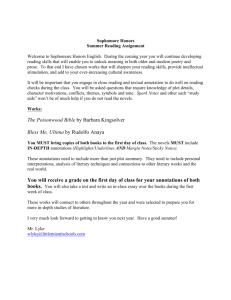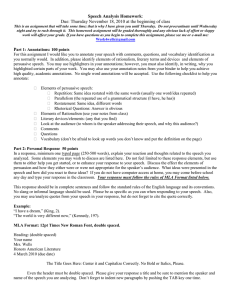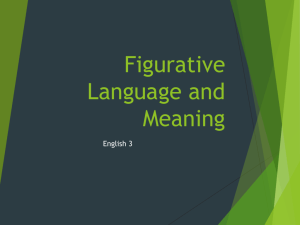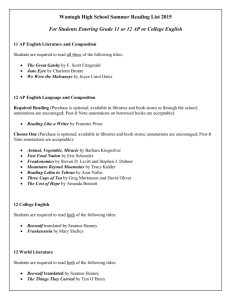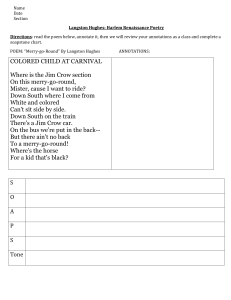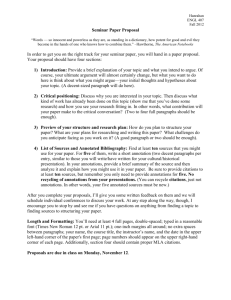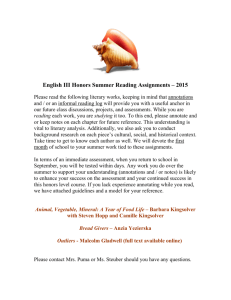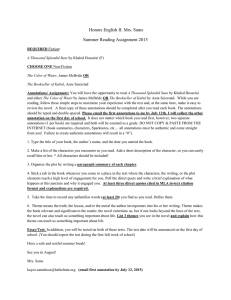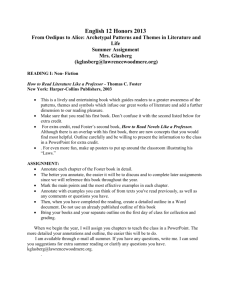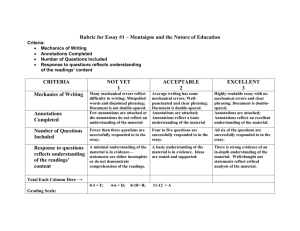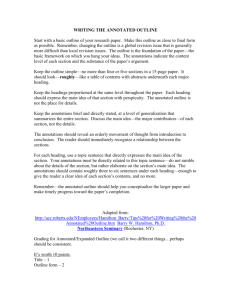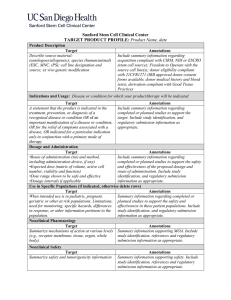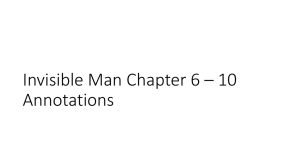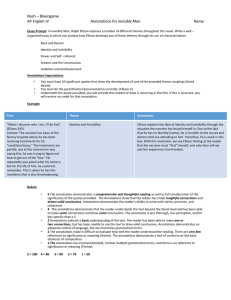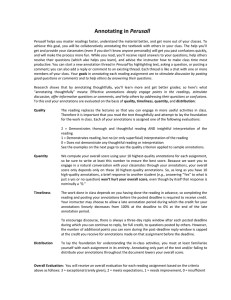The Three Levels of Reading
advertisement
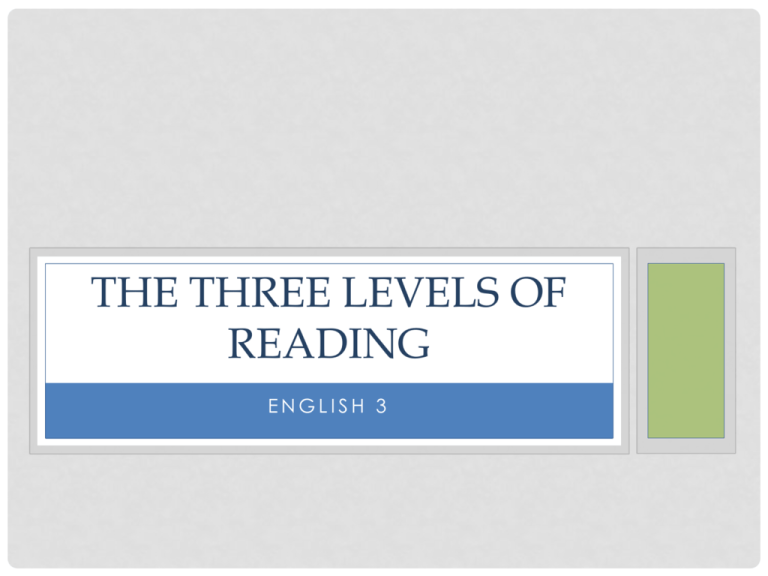
THE THREE LEVELS OF READING ENGLISH 3 BELLRINGER Choose one of the cartoons below. 1. Summarize what is going on in the cartoon. 2. What statement is the cartoon making about our society or culture? 3 Levels of Reading Reading on the Line (Literal) Reading Between the Lines (Inferential) Reading Beyond the Lines (Thematic) ON THE LINE Find meaning directly in the text. This is where you, the student, are reading for content. What did the author say? The facts reveal who, what, when, where, and why. BETWEEN THE LINES At this level we interpret the text. What does the passage represent, suggest or personify? What does a certain example of figurative language (like metaphor)mean? Analyze for: Interpretations Comparisons or Contrasts Repeated Ideas Patterns BEYOND THE LINES • Connect the text to UNIVERSAL meaning. • How does this text connect …. • with my life? • with life in a larger sense for all human beings? • with my ideas about morality, values, or what’s right and wrong? • What perception about life in general is the author communicating to me? • What do I think of those perceptions? • Move from the “what?” of the text to the “So what does that mean?” UNIVERSAL IDEAS (THEMES) • Universal ideas or themes carry the meaning of what is true for every human being on the planet. • The theme of a text describes an opinion about life, human nature or elements of society. • Some examples: • Friendship is dependent on sacrifice: This is the idea that you can't have friends if you don't act like a friend. • Crime does not pay: A popular theme played out in books throughout time is the concept that honesty is honored and criminals will eventually be caught. • Death is part of the life cycle. • Sacrifices and hard work pay off in the end, despite the challenges along the way. SUMMARIZING: WHAT’S UP? • On the Line— Just the Facts • Who, what, when, where, how, why? • Between the Lines– Interpret • Compare, contrast, analyze • Beyond the Lines– the UNIVERSAL idea • How does this apply to basic humanity? What does the text describe about life, human nature or elements of society? “THE TUNNEL” BY MARK STRAND • Read and annotate eight things. “The Tunnel” by Mark Strand A man has been standing in front of my house for days. I peek at him from the living room window and at night, unable to sleep, I shine my flashlight down on the lawn. He is always there. After a while I open the front door just a crack and order him out of my yard. He narrows his eyes and moans. I slam the door and dash back to the kitchen, then up to the bedroom, then down. I weep like a schoolgirl and make obscene gestures through the window. I write large suicide notes and place them so he can read them easily. I destroy the living room furniture to prove I own nothing of value. When he seems unmoved I decide to dig a tunnel to a neighboring yard. I seal the basement off from the upstairs with a brick wall. I dig hard and in no time the tunnel is done. Leaving my pick and shovel below, I come out in front of a house and stand there too tired to move or even speak, hoping someone will help me. I feel I’m being watched and sometimes I hear a man’s voice, but nothing is done and I have been waiting for days. WHEN I ANNOTATE, WHAT DO I WRITE? As you work with a text, consider all of the ways that you can connect with what you are reading. Here are some suggestions that will help you with your annotations: Record a REACTION Ask a QUESTION Give an OPINION Make a CONNECTION between two parts of a text, to yourself, or to the real world. Circle UNKNOWN words or phrases Underline IMPORTANT ideas, symbols, or figurative language Make notes about the TONE or MOOD RELATE to other things you’ve read, seen, or heard Mark INTERESTING WORDS and PHRASES ANNOTATION RUBRIC Points Criteria 4 • • • • • 3 • Demonstrates satisfactory understanding • Has many of the qualities of the annotations in the 4-point range but doesn‘t push far enough to remain at the upper levels of thinking • Annotations don’t always seem insightful or purposeful 2 • Annotations are too general • Thinking processes stay at lower levels of thinking (identification, comprehension) rather than moving into the upper levels (analysis, synthesis, evaluation) 1 • Annotations are vague • Shows a minimal amount of effort, understanding, or active reading • Has notes that look exactly like those of a neighbor or few to no annotations at all Demonstrates thorough understanding of the reading Only the most important concepts within the text are marked Demonstrates evidence of active reading Annotations are evenly distributed throughout the passage. Annotations would be useful later when the reader needs to recall the material Remember and Understand Reading on the Line 1. Write the most significant word from the text. 2. Quote the entire sentence in which the word appears and include the page, line or paragraph number. 3. Write at least two dictionary definitions of the word (denotation). 4. Explain why the word is important to the meaning of the work by placing it in the context of the narrative. Analyze and Interpret *Draw & Explain Reading Between the Lines 1. Referring to the text, draw FOUR images created from the text R *Draw & Explain Reading On the Line *Draw & Explain 2. Write an explanation of the connection between the four images from the text and the word you have written in the inner circle. *Draw & Explain Evaluate and Create Reading Beyond the Lines Reading Between the Lines Reading On the Lines Write TWO thematic statements drawn from the significant word you wrote in the innermost circle and the images you drew in the middle circle. These should be UNVERSAL theme statements.

